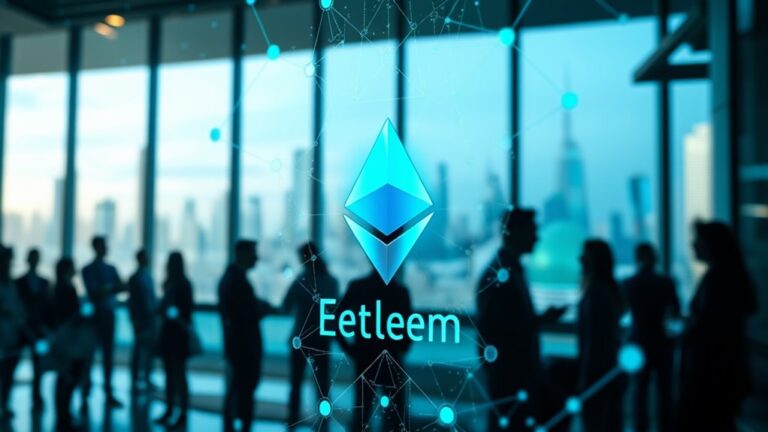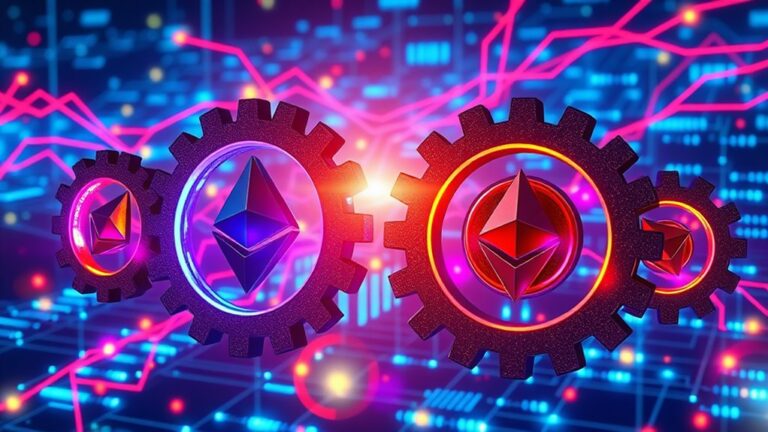
Ethereum Gas Fees Explained: What Are They & How Do They Work?
Ethereum gas fees are payments users make to compensate validators for executing transactions on the blockchain. These fees are calculated using the formula (base fee + priority fee) × gas limit, with prices measured in gwei (a fraction of ETH). Gas fees prevent network spam, create a transaction priority system, and fluctuate based on network congestion. Base fees are algorithmically determined and burned after use, while priority fees reward validators directly. Understanding gas mechanics helps users optimize their transaction costs greatly.
Key Takeaways
- Gas fees are payments to validators for processing Ethereum transactions, calculated by multiplying gas units by the current gas price.
- Ethereum’s fee structure consists of base fees (algorithmically determined) and priority fees (optional tips for faster processing).
- Transaction costs vary based on complexity—simple transfers require 21,000 gas units while smart contracts demand substantially more.
- Network congestion directly impacts gas prices, with busy periods leading to higher fees through supply and demand mechanics.
- Layer 2 solutions like Optimistic Rollups process transactions off-chain to significantly reduce gas fees while maintaining Ethereum’s security.
Ethereum Gas Fees Explained: What Are They & How Do They Work?

When users interact with the Ethereum blockchain, they encounter a critical component known as gas fees, which serve as the financial backbone of the network’s operations.
These fees, paid in ETH cryptocurrency, represent the computational power required to process transactions and execute smart contracts on the blockchain.
Gas fees function similarly to how gasoline powers vehicles—they fuel the Ethereum network’s ability to securely process operations.
The fee structure follows a specific formula: (base fee + priority fee) × gas limit.
The base fee adjusts automatically based on network congestion and gets burned, while the priority fee acts as an optional tip to validators who process transactions.
As the Ethereum DeFi ecosystem continues to grow, understanding decentralized finance becomes increasingly important for users navigating gas fees and transaction costs.
The Fundamentals of Ethereum Gas

Gas functions as the essential digital fuel that powers all operations on the Ethereum blockchain, requiring payment for every computational step executed.
The pricing mechanism for gas operates on a unit basis, with each operation (like transfers or smart contract executions) assigned a specific gas cost measured in units.
These gas units, when multiplied by the current gas price (measured in gwei), determine the total transaction fee users must pay to have their transactions processed by network validators. The transition to Proof of Stake has also contributed to an increase in transaction efficiency, potentially impacting gas fees in the future.
Gas as Digital Fuel
The digital economy of Ethereum operates on a fundamental resource known as gas, which serves as the essential fuel powering all network operations. This computational measurement unit represents the effort required to execute transactions and smart contracts on the blockchain.
Similar to how a car needs gasoline to run, every Ethereum action requires a specific amount of gas to process. Basic transactions, like sending ETH from one wallet to another, consume minimal gas, while complex smart contract interactions demand considerably more. The gas requirement reflects the computational complexity of the operation.
Importantly, gas fees serve multiple purposes: they compensate validators for their work securing the network, prevent spam transactions by imposing costs, and create an efficient marketplace where users bid for transaction processing priority during periods of network congestion. Additionally, understanding smart contracts is crucial for comprehending the varying gas requirements associated with different Ethereum operations.
Unit Pricing Mechanics
Every transaction on the Ethereum network involves a sophisticated pricing structure that determines its processing cost. This system uses units called “gas” to measure computational effort, with fees paid in gwei, a fraction of Ether (ETH).
The total gas fee follows a formula: Gas limit × (Base fee + Priority fee). Users specify a gas limit for their transaction, while the base fee adjusts automatically with network congestion.
| Component | Function | User Control |
|---|---|---|
| Gas Limit | Maximum computational units | User-defined |
| Base Fee | Network-determined cost | Algorithmically set |
| Priority Fee | Optional validator tip | User-defined |
Any unused gas from the specified limit is refunded after transaction completion. Setting an appropriate gas limit is essential—too low causes transaction failure, while excess simply returns to the user’s wallet. Additionally, developments such as Ethereum 2.0 are expected to enhance scalability, which could lead to lower gas fees in the future.
Why Gas Fees Are Essential for Ethereum

Although often misunderstood as mere transaction costs, Ethereum gas fees serve as the critical foundation for the network’s security, functionality, and longevity. These fees incentivize validators to process transactions and secure the network in a decentralized manner, particularly since Ethereum’s shift to Proof of Stake.
Gas fees play multiple crucial roles in the ecosystem. They prevent network spam by making it economically impractical for malicious actors to overwhelm the system with unnecessary transactions.
During periods of high congestion, fees increase naturally through supply and demand mechanics, prioritizing more valuable transactions. For DeFi applications and dApps, these fees guarantee computational resources are allocated efficiently, supporting their economic viability despite the sometimes substantial user costs. Additionally, the ongoing development of scaling solutions, including Layer 2 protocols, aims to address these costs while maintaining security.
How Ethereum Gas Fees Are Calculated

Understanding Ethereum gas fees requires breaking down their components into digestible pieces. Gas fees are calculated using a formula that multiplies the units of gas used by the sum of the base fee and priority fee.
The calculation involves several key elements: gas limit (maximum gas a user will spend), gas price (ETH paid per unit of gas), base fee (network-determined rate), and priority fee (optional tip for faster processing).
For example, a simple ETH transfer typically requires 21,000 gas units. When setting a gas price at 100 gwei (a billionth of ETH), this transaction would cost 2,100,000 gwei, or approximately 0.0021 ETH.
More complex operations like smart contract executions require higher gas limits, resulting in proportionally higher fees. This is particularly relevant as Ethereum’s transition to Proof of Stake aims to improve transaction efficiency and scalability.
The Impact of Network Congestion on Gas Prices

Network congestion serves as the primary driver behind Ethereum’s fluctuating gas prices, creating a digital traffic jam that affects all users of the blockchain. When transaction volume increases beyond network capacity, users must compete for limited block space by offering higher gas fees.
During peak congestion periods, users experience:
- Considerably higher transaction costs as they bid against each other for processing priority.
- Longer wait times for transactions with standard gas prices.
- Potential transaction failures if gas prices are set too low.
- Price unpredictability making budgeting difficult for regular users.
Layer-2 solutions like Optimism and Arbitrum help alleviate this congestion by processing transactions off the main Ethereum chain. Additionally, timing non-urgent transactions during off-peak hours can substantially reduce gas costs. Furthermore, the rise of decentralized finance (DeFi) has increased the demand for Ethereum transactions, further contributing to network congestion.
Base Fees vs. Priority Fees: Understanding the Difference

Ethereum’s gas fee structure consists of two distinct components: base fees, which are required core payments that are automatically burned, and optional priority fees that go directly to validators as rewards.
The base fee is algorithmically determined by the network based on demand for block space, ensuring consistent network operation while helping reduce ETH supply through burning.
Priority fees, on the other hand, function as tips that users can adjust according to their transaction urgency, creating a market-based mechanism for transaction processing preference during congested periods.
Core vs. Optional Payments
While transacting on the Ethereum network, users encounter two distinct types of gas fees that serve different purposes in the ecosystem. The fee structure consists of base fees and priority fees, each playing a unique role in transaction processing.
- Base fees are mandatory payments determined algorithmically by the network to manage congestion and keep blocks approximately 50% full.
- Priority fees are optional incentives users can add to encourage validators to prioritize their transactions during busy periods.
- Base fees are burned, creating a deflationary mechanism that reduces ETH supply over time.
- Priority fees go directly to validators as rewards for their participation in the network.
This dual structure provides a balance between predictable pricing and user choice while maintaining network efficiency. Additionally, understanding Ethereum staking rewards can enhance users’ awareness of how their transactions contribute to the overall ecosystem.
Auto-Burn vs. Validator Rewards
After implementing EIP-1559, Ethereum’s gas fee structure underwent a fundamental transformation that created two distinct fee components with separate destinations and purposes.
The base fee, which adjusts according to network congestion, is automatically burned during transactions, permanently removing ETH from circulation. Approximately 4.4 million ETH ($12.3 billion) has been burned since implementation, creating deflationary pressure on Ethereum’s supply.
In contrast, priority fees function as optional tips paid directly to validators who process transactions. Under Ethereum’s Proof-of-Stake system, these validators (who must stake 32 ETH) receive only these priority fees as transaction-related income, not the base fees.
Users can adjust priority fee amounts to incentivize faster processing during congested periods, creating a market-based system for transaction speed while maintaining the deflationary benefits of base fee burning. Additionally, understanding smart contract vulnerabilities is crucial for users to protect themselves against potential risks associated with transaction processing on the Ethereum network.
Strategies to Reduce Your Ethereum Transaction Costs

When traversing the often costly world of Ethereum transactions, users can employ several effective strategies to minimize their gas fees. Understanding these approaches can lead to significant savings while maintaining transaction effectiveness.
Savvy Ethereum users strategically navigate gas fees, balancing cost optimization with transaction efficiency.
- Time transactions strategically – Execute transactions during off-peak hours like nights and weekends when network congestion is lower, resulting in reduced fees.
- Batch multiple transactions – Combine several operations into a single transaction using platforms like Ambire Wallet to minimize overall costs.
- Optimize smart contracts – Reduce contract complexity and computational requirements to lower execution costs.
- Consider alternative blockchains – For non-urgent transactions, networks like Binance Smart Chain and Solana offer similar functionality with substantially lower fees.
Additionally, staying informed about upcoming Ethereum upgrades, such as Dencun and Pectra, can help users anticipate changes in gas fees and network performance.
Layer 2 Solutions: The Future of Affordable Ethereum Transactions

As Ethereum’s popularity continues to soar, Layer 2 solutions have emerged as the most promising pathway to affordable transactions on the blockchain. These technologies operate above the main Ethereum network, processing transactions off-chain before submitting them to Layer 1 for validation.
The ecosystem includes several key technologies: Optimistic Rollups, which use economic incentives; ZK Rollups, which employ cryptographic proofs; and platforms like Polygon, Arbitrum, and zkSync Era. With approximately $16 billion in total value locked, these solutions are gaining significant traction.
Layer 2 solutions offer compelling advantages: dramatically reduced fees, faster transaction speeds, enhanced scalability, and smart contract compatibility. By handling more transactions without congesting the main network, these technologies are increasingly essential to Ethereum’s long-term sustainability and accessibility.
Historical Gas Fee Trends and What They Tell Us

The historical patterns of Ethereum gas fees tell a compelling story about the network’s evolution and market dynamics. Initially stable, gas fees have experienced significant volatility tied directly to network demand, with dramatic spikes during periods of high activity such as NFT launches or DeFi surges.
Recent data reveals several remarkable trends:
- Gas fees recently hit a five-year low, dropping 95% from March 2024 levels.
- This decline coincides with reduced demand and migration to competing blockchains.
- Network upgrades like Dencun have improved efficiency, further reducing costs.
- Historically, extreme fee drops have often preceded ETH price rebounds.
These patterns illustrate how gas fees function as both economic indicators and network health metrics, reflecting the balance between transaction demand and Ethereum’s processing capacity.
Frequently Asked Questions
Can Gas Fees Be Paid Using Tokens Other Than ETH?
Currently, Ethereum gas fees must be paid using ETH only. No direct methods exist for paying gas fees with other tokens, though some platforms offer indirect solutions to help users manage transaction costs.
Do Failed Transactions Still Incur Gas Fees?
Failed transactions on Ethereum still incur gas fees because computational resources are consumed during processing. Validators charge for their work regardless of transaction outcome, though only the gas used before failure is charged.
How Do Ethereum Gas Fees Compare to Other Blockchain Networks?
Ethereum gas fees typically exceed those on networks like Binance Smart Chain, Polygon, and Solana. These alternatives offer faster transactions and lower costs due to different consensus mechanisms and higher throughput capabilities.
Are Gas Fees Tax-Deductible in Most Jurisdictions?
Gas fees’ tax-deductibility varies considerably by jurisdiction. In some areas, they may be deductible for business-related transactions or as adjustments to cost basis, but personal transactions often receive different treatment.
Will Ethereum 2.0 Completely Eliminate High Gas Fees?
Like a river finding new paths when faced with dams, Ethereum 2.0 will greatly reduce, but not completely eliminate high gas fees. Network demand will still influence costs despite improved scalability through sharding.
Conclusion
Ethereum gas fees remain a critical aspect of the network’s functionality, evolving alongside blockchain technology itself. Understanding these costs helps users navigate transactions more efficiently, like stagecoach travelers planning routes to avoid highway robbers. As Layer 2 solutions continue to develop and network upgrades progress, users can look forward to more affordable transaction options while still benefiting from Ethereum’s robust security and decentralization features.












